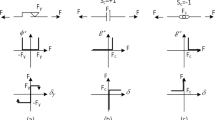Abstract
An optimization method which combines an indirect method with homotopic approach is proposed and applied to impulsive trajectories. Minimum-fuel, multiple-impulse solutions, with either fixed or open time are obtained. The homotopic approach at hand is relatively straightforward to implement and does not require an initial guess of adjoints, unlike previous adjoints estimation methods. A multiple-revolution Lambert solver is used to find multiple starting solutions for the homotopic procedure; this approach can guarantee to obtain multiple local solutions without relying on the user’s intuition, thus efficiently exploring the solution space to find the global optimum. The indirect/homotopic approach proves to be quite effective and efficient in finding optimal solutions, and outperforms the joint use of evolutionary algorithms and deterministic methods in the test cases.















Similar content being viewed by others
References
Lawden, D.F.: Optimal Trajectories for Space Navigation. Butterworths, London (1963)
Lion, P.M., Handelsman, M.: Primer vector on fixed-time impulsive trajectories. AIAA J. 6(1), 127–132 (1968). doi:10.2514/3.4452
Jezewski, D.J., Rozendaal, H.L.: An efficient method for calculating optimal free-space n-impulse trajectories. AIAA J. 6(11), 2160–2165 (1968). doi:10.2514/3.3607
Prussing, J.E.: A class of optimal two-impulse rendezvous using multiple-revolution lambert solutions. J. Astron. Sci. 48(2), 131–148 (2000)
Prussing J.E., Chiu, J.H.: Optimal multiple-impulse time-fixed rendezvous between circular orbits. J. Guid, Control, Dyn. 9(1), 17–22 (1986). doi:10.2514/3.20060
Hughes S.P., Mailhe, L.M., Guzman, J.J.: A Comparison of trajectory optimization methods for the impulsive minimum fuel rendezvous problem. Adv. Astron. Sci. 113, 85–104 (2003)
Abdelkhalik, O., Mortari, D.: N-impulse orbit transfer using genetic algorithms. J. Spacecr. Rocket. 44(2), 456–460 (2007). doi:10.2514/1.24701
Pontani, M., Ghosh, P., Conway, B.A.: Particle swarm optimization of multiple-burn rendezvous trajectories. J. Guid. Control Dyn. 35(4), 1192–1207 (2012). doi:10.2514/1.55592
Luo, Y.Z., Tang, G.J., Lei, Y.J., et al.: Optimization of multiple-impulse multiple-revolution rendezvous phasing maneuvers. J. Guid. Control Dyn. 30(4), 46–952 (2007). doi:10.2514/1.25620
Luo, Y.Z., Zhang, J., Li, H.Y., et al.: Interactive optimization approach for optimal impulsive rendezvous using primer vector and evolutionary algorithms. Acta Astron. 67(3), 396–405 (2010). doi:10.1016/j.actaastro.2010.02.014
Rosa Sentinella, M., Casalino, L.: Cooperative evolutionary algorithm for space trajectory optimization. Celestial Mech. Dyn. Astron. 105, 211–227 (2009). doi:10.1007/s10569-009-9223-4
Colasurdo, G., Pastrone, D.: Indirect Optimization Method for Impulsive Transfer, AIAA Paper 1994-3762, 1994. doi:10.2514/6.1994-3762
Chilan, C.: Automated Design of Multiphase Space Missions Using Hybrid Optimal Control. Ph.D. thesis, University of Illinois (2009)
Chilan, C., Conway, B.A.: Automated design of multiphase space missions using hybrid optimal control. J. Guid. Control Dyn. 36(5), 1410–1424 (2013). doi:10.2514/1.58766
Casalino, L., Colasurdo, G., Pastrone, D.: Optimization procedure for preliminary design of opposition-class mars missions. J. Guid. Control Dyn. 21(1), 134–140 (1998). doi:10.2514/2.4209
Casalino, L., Colasurdo, G., Pastrone, D.: Optimization of ΔV earth-gravity-assist trajectories. J. Guid. Control Dyn. 21(6), 991–995 (1998). doi:10.2514/2.4336
Haberkorn, T., Martinon, P., Gergaud, J.: Low thrust minimum-fuel orbital transfer: a homotopic approach. J. Guid. Control Dyn. 27(6), 1046–1060 (2004). doi:10.2514/1.4022
Jiang, F., Baoyin, H., Li, J.: Practical techniques for low-thrust trajectory optimization with homotopic approach. J. Guid. Control Dyn. 35(1), 245–258 (2012). doi:10.2514/1.52476
Bertrand, R., Epenoy, R.: New smoothing techniques for solving bang-bang optimal control problems-numerical results and statistical interpretation. Opt. Control Appl. Methods 23(4), 171–197 (2002). doi:10.1002/oca.709
Shen, H.-X., Casalino, L., Li, H.-Y.: Adjoints estimation methods for impulsive moon-to-earth trajectories in the restricted three-body problem. Opt. Control Appl. Methods (2014). doi:10.1002/oca.2120
Shen, H.-X., Casalino, L.: Indirect optimization of three-dimensional multiple-impulse moon-to-earth transfers, to be published in the journal of astronautical sciences. doi:10.1007/s40295-014-0018-9
Bryson, A.E., Ho, Y.-C.: Applied Optimal Control, pp 42–89. Rev. ed., Hemisphere, Washington, DC (1975)
Casalino, L., Colasurdo, G., Pastrone, D.: Optimal low-thrust escape trajectories using gravity assist. J. Guid. Control Dyn. 22(5), 637–642 (1999). doi:10.2514/2.4451
Brown, C.D.: Spacecraft Mission Design, 2nd, pp 39–51. AIAA, Reston, VA (1998)
Vallado, D.A.: Fundamental of Astrodynamics and Applications, 2nd, pp 122–343. Microcosm Press, El Segundo, CA, and Kluwer Academic, Boston, MA (2001)
Der, G.: The Superior Lambert Algorithm,” Proceedings of the Advanced Maui Optical and Space Surveillance Technologies Conference. held in Wailea, Maui, Hawaii (2011)
Edelbaum, T.N.: How Many Impulses?, pp 64–69. Astronautics and Aeronautics (1967)
Baranov, A.A., Roldugin, D.S.: Six-impulse maneuvers for rendezvous of spacecraft in near-circular noncoplanar orbits. Cosm. Res. 50(6), 472–479 (2012)
Acknowledgments
The third author would like to thank the National Natural Science Foundation of China (no. 11222215), the Program for New Century Excellent Talents in University (NCET-13-0159), and the Project supported by Hunan Provincial Natural Science Foundation of China (13JJ1001) for their support to this work.
Author information
Authors and Affiliations
Corresponding author
Rights and permissions
About this article
Cite this article
Shen, HX., Casalino, L. & Luo, YZ. Global Search Capabilities of Indirect Methods for Impulsive Transfers. J of Astronaut Sci 62, 212–232 (2015). https://doi.org/10.1007/s40295-015-0073-x
Published:
Issue Date:
DOI: https://doi.org/10.1007/s40295-015-0073-x




